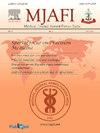COVID-19感染诱导补体介导的血栓性微血管病1例
Q2 Medicine
引用次数: 0
摘要
SARS-CoV-2病毒可通过替代途径激活引起血栓性微血管病(TMA)。我们提出一个病例的年轻女性患者谁提出发烧和透析依赖急性肾损伤。经评估,她被诊断为covid -19诱导的补体介导的血栓性微血管病(CM-TMA)。她最初接受血浆置换(PLEX)治疗。然而,由于对PLEX的反应不佳,她被给予注射Eculizumab。她成为透析独立,并在随访时肾功能正常。本文章由计算机程序翻译,如有差异,请以英文原文为准。
Case of COVID-19 infection-induced complement-mediated thrombotic microangiopathy
The SARS-CoV-2 virus can cause thrombotic microangiopathy (TMA) by alternate pathway activation. We present a case of a young female patient who presented with fever and dialysis-dependent acute kidney injury. On evaluation, she was diagnosed with COVID-19-induced complement-mediated thrombotic microangiopathy (CM-TMA). She was initially managed with plasma exchange (PLEX). However, because of poor response to PLEX, she was administered Inj Eculizumab. She became dialysis independent and had normal renal function on follow-up visits.
求助全文
通过发布文献求助,成功后即可免费获取论文全文。
去求助
来源期刊

Medical Journal Armed Forces India
Medicine-Medicine (all)
CiteScore
3.40
自引率
0.00%
发文量
206
期刊介绍:
This journal was conceived in 1945 as the Journal of Indian Army Medical Corps. Col DR Thapar was the first Editor who published it on behalf of Lt. Gen Gordon Wilson, the then Director of Medical Services in India. Over the years the journal has achieved various milestones. Presently it is published in Vancouver style, printed on offset, and has a distribution exceeding 5000 per issue. It is published in January, April, July and October each year.
 求助内容:
求助内容: 应助结果提醒方式:
应助结果提醒方式:


